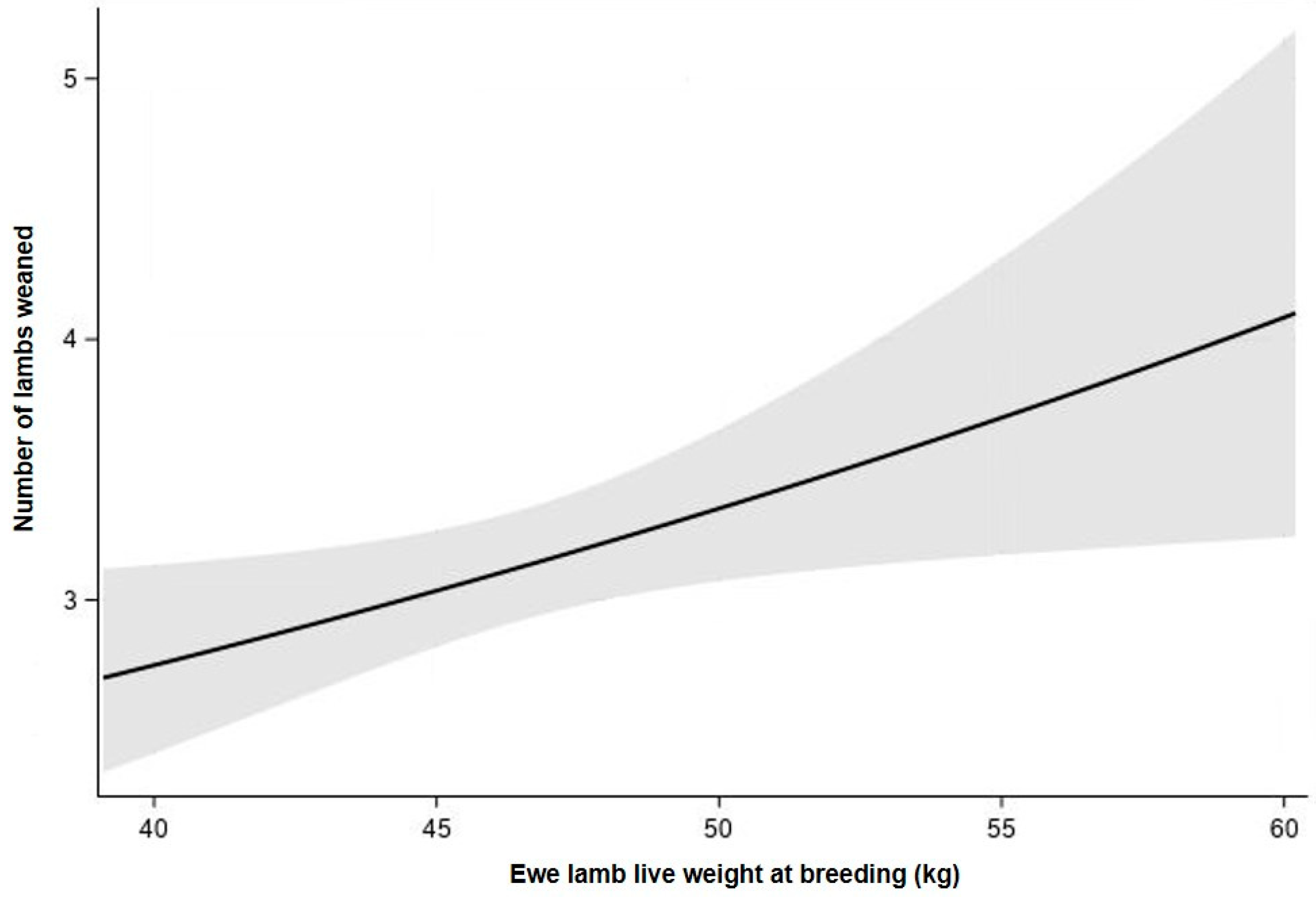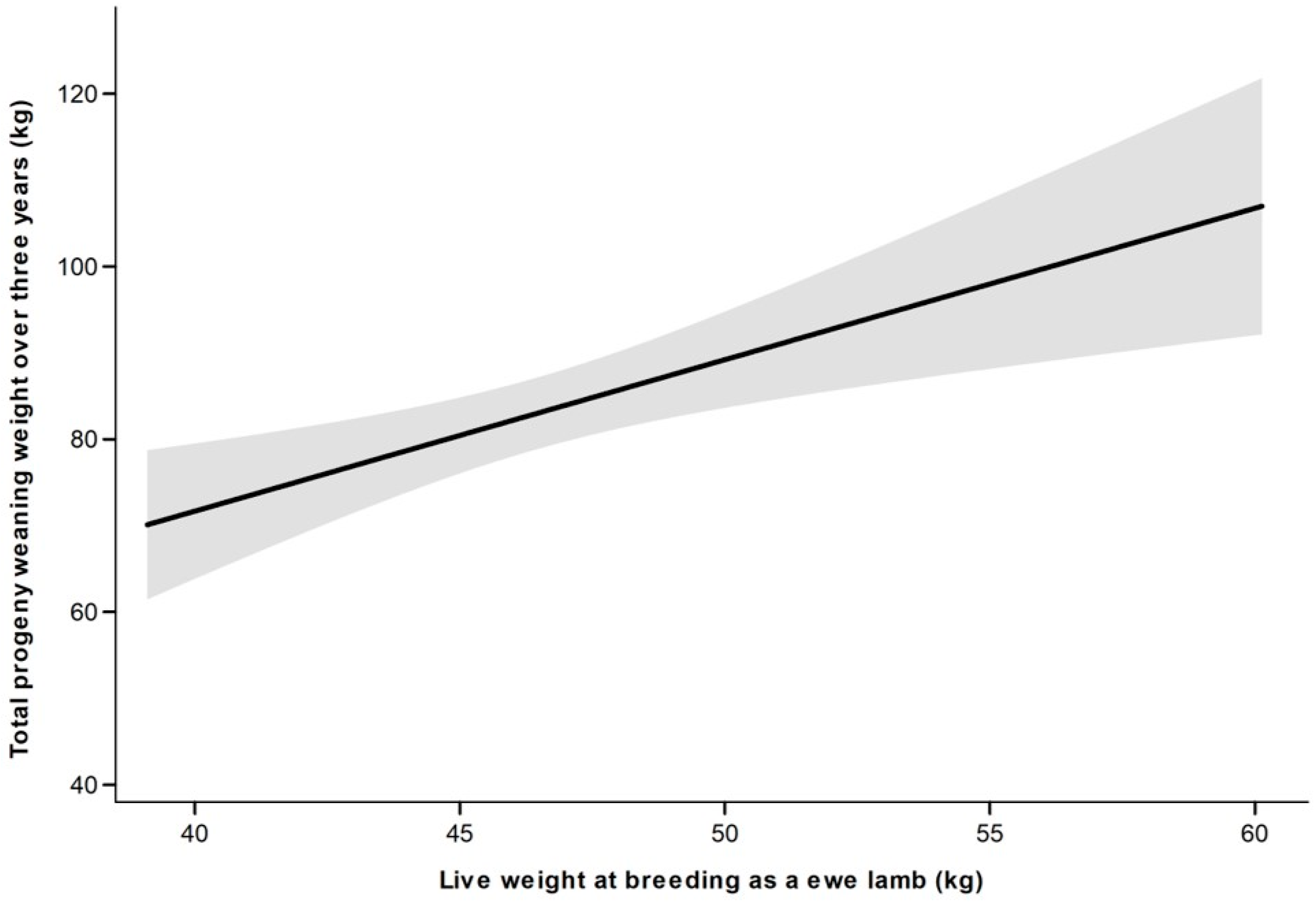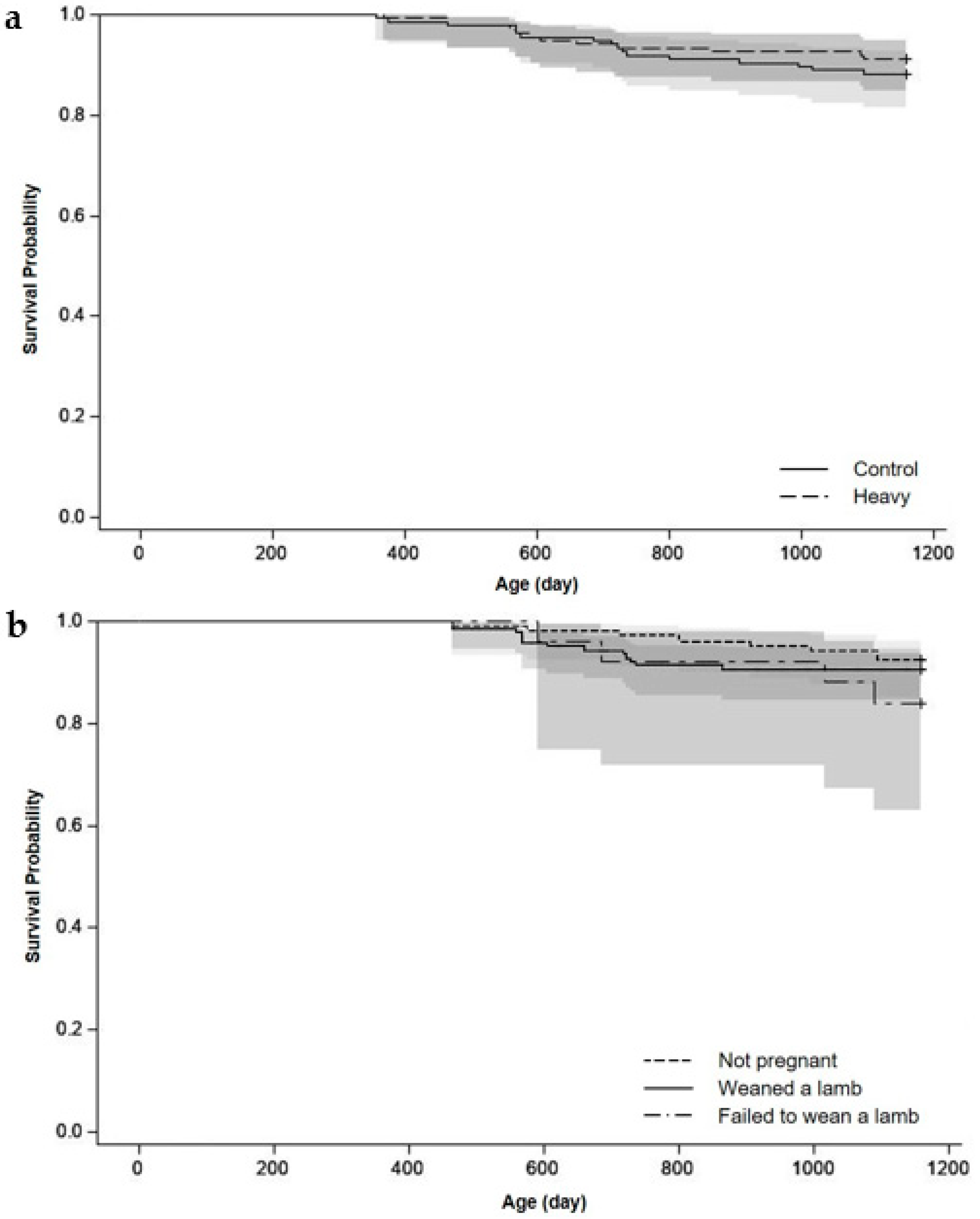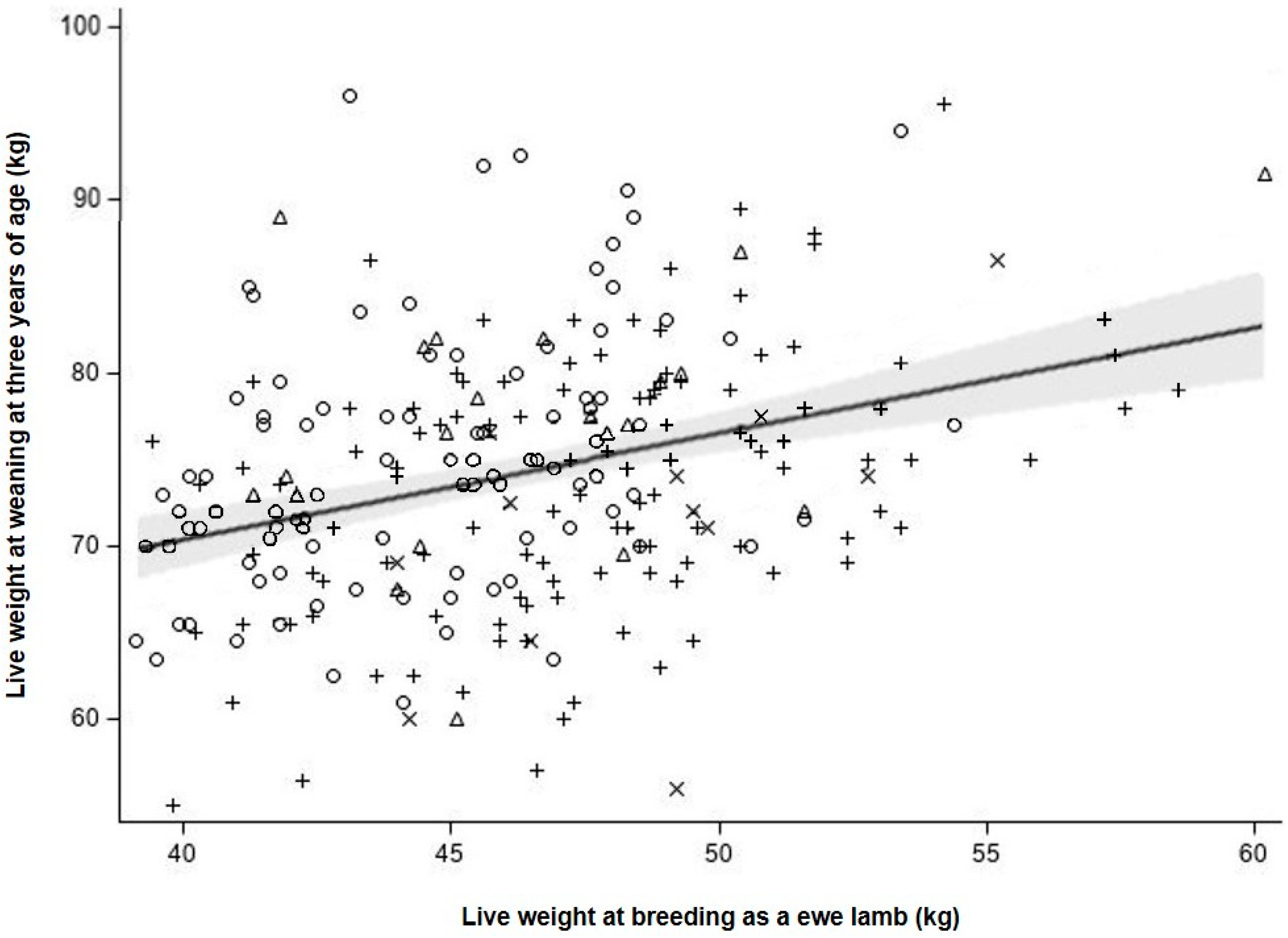Effect of Breeding Heavier Romney Ewe Lambs at Seven Months of Age on Lamb Production and Efficiency over Their First Three Breeding Seasons
Abstract
Simple Summary
Abstract
1. Introduction
2. Materials and Methods
2.1. Experimental Design
2.2. Feeding Management
2.3. Animal Measurements
2.4. Data Management
2.4.1. Ewe Lamb Status
2.4.2. Number and Live Weight of Lambs
2.4.3. Efficiency
2.4.4. Survival
2.5. Statistical Analyses
3. Results
3.1. Ewe Live Weight and BCS
3.2. Lamb Production
3.2.1. Treatment Effect
3.2.2. Effect of Live Weight at Ewe Lamb Breeding Irrespective of Treatment
3.3. Efficiency
3.4. Ewe Survival to Three Years of Age (d1159)
3.5. Relationship between Ewe Lamb Breeding Live Weight and Ewe Mature Weight
4. Discussion
4.1. Effect of Heavier Ewe Lamb Live Weight on Lamb Production and Efficiency
4.2. Impact of Successfully Weaning a Lamb as a Ewe Lamb on Subsequent Production and Efficiency
4.3. Relationship between Ewe Lamb Breeding Live Weight and Ewe Live Weight at 39 Months of Age
5. Conclusions
Author Contributions
Funding
Institutional Review Board Statement
Informed Consent Statement
Data Availability Statement
Acknowledgments
Conflicts of Interest
Appendix A. Ewe Energy Requirement Equations
- Ewe Maintenance [16]
- 2.
- Ewe Liveweight Change [16]
- 3.
- Ewe Pregnancy Requirement [16]
- 4.
- 5.
- Total Ewe Daily Requirement
References
- Kenyon, P.R.; Thompson, A.N.; Morris, S.T. Breeding ewe lambs successfully to improve lifetime performance. Small Rumin. Res. 2014, 118, 2–15. [Google Scholar] [CrossRef]
- Gaskins, C.T.; Snowder, G.D.; Westman, M.K.; Evans, M. Influence of body weight, age, and weight gain on fertility and prolificacy in four breeds of ewe lambs. J. Anim. Sci. 2005, 83, 1680–1689. [Google Scholar] [CrossRef]
- Corner-Thomas, R.A.; Kenyon, P.R.; Ridler, A.L.; Paganoni, B.L.; Morris, S.T. The Relationship between Breeding Liveweight and the Fertility and Reproductive Rates of Ewe Lambs. Proc. Aust. Soc. Anim. Prod. 2014, 30, 185. [Google Scholar]
- Thompson, A.N.; Bowen, E.; Keiller, J.; Pegler, D.; Kearney, G.; Rosales-Nieto, C.A. The number of offspring weaned from ewe lambs is affected differently by liveweight and age at breeding. Animals 2021, 11, 2733. [Google Scholar] [CrossRef]
- Ponzoni, R.W.; Azzarini, M.; Walker, S.K. Production in mature corriedale ewes first mated at 7 to 11 or 18 months of age. Anim. Sci. 1979, 29, 385–391. [Google Scholar] [CrossRef]
- Baker, R.L.; Clarke, J.N.; Diprose, G.D. Effect of mating Romney ewe hoggets on lifetime production-preliminary results. Proc. N. Z. Soc. Anim. Prod. 1981, 41, 198–203. [Google Scholar]
- Kenyon, P.R.; van der Linden, D.S.; West, D.M.; Morris, S.T. The effect of breeding hoggets on lifetime performance. N. Z. J. Agric. Res. 2011, 54, 321–330. [Google Scholar] [CrossRef]
- González-García, E.; Hazard, D. Growth rates of Romane ewe lambs and correlated effects of being mated as hoggets or two-tooth ewes on first offspring performance. Livest. Sci. 2016, 189, 63–69. [Google Scholar] [CrossRef]
- Thomson, B.C.; Smith, N.B.; Muir, P.D. Effect of birth rank and age at first lambing on lifetime performance and ewe efficiency. N. Z. J. Agric. Res. 2020, 64, 529–539. [Google Scholar] [CrossRef]
- Thomas, D.L.; Berger, Y.M. Effects of Prepubertal Growth Rate of Ewe Lambs on their Subsequent Lamb and Milk Production. In Proceedings of the Great Lakes Dairy Sheep Symposium, Albany, NY, USA, 12–14 November 2009; p. 78. [Google Scholar]
- Haslin, E.; Corner-Thomas, R.A.; Kenyon, P.R.; Pettigrew, E.J.; Hickson, R.E.; Morris, S.T.; Blair, H.T. Effects of heavier live weight of ewe lambs at mating on fertility, lambing percentage, subsequent live weight and the performance of their progeny. N. Z. J. Agric. Res. 2020, 1–15. [Google Scholar] [CrossRef]
- Haslin, E.; Corner-Thomas, R.A.; Kenyon, P.R.; Pettigrew, E.J.; Hickson, R.E.; Morris, S.T.; Blair, H.T. Breeding heavier ewe lambs at seven months of age did not impact their subsequent two and three-year-old ewe live weight and reproductive performance. N. Z. J. Agric. Res. 2021, 1–16. [Google Scholar] [CrossRef]
- Coop, I.E.; Hayman, B.I. Liveweight-productivity relationships in sheep—II. Effect of liveweight on production and efficiency of production of lamb and wool. N. Z. J. Agric. Res. 1962, 5, 265–277. [Google Scholar] [CrossRef][Green Version]
- Baker, R.D.; Large, R.V.; Spedding, C.R.W. Size of Animal in Relation to Productivity with Special Reference to the Ruminant—Economic aspects. Proc. Br. Soc. Anim. Prod. 1973, 2, 35–42. [Google Scholar] [CrossRef]
- Sise, J.A.; Shackell, G.H.; Byrne, T.J.; Glennie, S.F.; Amer, P.R. A simulation model to partition ewe efficiency into component traits for genetic analysis. Proc. N. Z. Soc. Anim. Prod. 2009, 69, 223–227. [Google Scholar]
- Nicol, A.M.; Brookes, I.M. Chapter 10—The Metabolisable Energy Requirement of Grazing Livestock. In Pasture and Supplements for Grazing Animals; Rattray, P.V., Brooks, I.M., Nicol, A.M., Eds.; New Zealand Society of Animal Production: Hamilton, New Zealand, 2017; pp. 151–172. [Google Scholar]
- Holmes, W. Size of animal in relation to productivity nutritional aspects. Proc. Br. Soc. Anim. Prod. 1973, 2, 27–34. [Google Scholar] [CrossRef]
- Jefferies, B.C. Body condition scoring and its use in management. Tasman. J. Agric. 1961, 32, 19–21. [Google Scholar]
- Russel, A.J.F.; Doney, J.M.; Gunn, R.G. Subjective assessment of body fat in live sheep. J. Agric. Sci. 1969, 72, 451–454. [Google Scholar] [CrossRef]
- Pettigrew, E.J.; Hickson, R.E.; Morris, S.T.; Lopez-Villalobos, N.; Pain, S.J.; Kenyon, P.R.; Blair, H.T. The effects of birth rank (single or twin) and dam age on the lifetime productive performance of female dual purpose sheep (Ovis aries) offspring in New Zealand. PLoS ONE 2019, 14, e0214021. [Google Scholar] [CrossRef]
- Freer, M.; Dove, H.; Nolan, J.V. Energy. In Nutrient Requirements of Domesticated Ruminants; Freer, M., Dove, H., Nolan, J.V., Eds.; CSIRO Publishing: Collingwood, Australia, 2007; pp. 1–69. [Google Scholar]
- O’Neill, B.F.; Lewis, E.; O’Donovan, M.; Shalloo, L.; Mulligan, F.J.; Boland, T.M.; Delagarde, R. Evaluation of the GrazeIn model of grass dry-matter intake and milk production prediction for dairy cows in temperate grass-based production systems. 1–S ward characteristics and grazing management factors. Grass Forage Sci. 2013, 68, 504–523. [Google Scholar] [CrossRef]
- Halas, V.; Dijkstra, J.; Babinszky, L.; Verstegen, M.; Gerrits, W. Modelling of nutrient partitioning in growing pigs to predict their anatomical body composition. 2. Model evaluation. Br. J. Nutr. 2004, 92, 725–734. [Google Scholar] [CrossRef][Green Version]
- Peart, J.N.; Edwards, R.A.; Donaldson, E. The yield and composition of the milk of Finnish Landrace × Blackface ewes: II. Ewes and lambs grazed on pasture. J. Agric. Sci. 1975, 85, 315–323. [Google Scholar] [CrossRef]
- Litherland, A.J.; Woodward, S.J.R.; Stevens, D.R.; McDougal, D.B.; Boom, C.J.; Knight, T.L.; Lambert, M.G. Seasonal variations in pasture quality on New Zealand sheep and beef farms. Proc. N. Z. Soc. Anim. Prod. 2002, 62, 138–142. [Google Scholar]
- Kenyon, P.R. Hogget Performance: Unlocking the Potential; Beef+ Lamb: Wellington, New Zealand, 2012. [Google Scholar]
- Cranston, L.M.; Ridler, A.L.; Greer, A.W.; Kenyon, P.R. Chapter 3—Sheep Production. In Livestock Production in New Zealand; Stafford, K., Ed.; Massey University Press: Auckland, New Zealand, 2017; pp. 86–123. [Google Scholar]
- Pettigrew, E.; Hickson, R.; Morris, S.; Kenyon, P.; Corner-Thomas, R.; Haslin, E.; Blair, H. The Effect of Age of Dam and Birth Rank on the Reproductive Performance of Ewes as One-and Two-Year-Olds. Animals 2021, 11, 770. [Google Scholar] [CrossRef]
- Amer, P.R.; Sise, J.A.; Jopson, N.B.; Bray, A.R. Background effects on ewe lambing and weaning performance in well recorded breeding flocks. Proc. N. Z. Soc. Anim. Prod. 2009, 69, 115–117. [Google Scholar]
- Griffiths, K.J.; Ridler, A.L.; Heuer, C.; Corner-Thomas, R.A.; Kenyon, P.R. Associations between liveweight, body condition score and previous reproductive outcomes, and the risk of ewes bred at 18-months of age being dry at docking. N. Z. Vet. J. 2018, 66, 290–296. [Google Scholar] [CrossRef] [PubMed]
- Fogarty, N.M.; Ingham, V.M.; Gilmour, A.R.; Afolayan, R.A.; Cummins, L.; Edwards, J.E.H.; Gaunt, G.M. Genetic evaluation of crossbred lamb production. 5. Age of puberty and lambing performance of yearling crossbred ewes. Aust. J. Agric. Res. 2007, 58, 928–934. [Google Scholar] [CrossRef]
- Conington, J.; Bishop, S.C.; Waterhouse, A.; Simm, G. A bioeconomic approach to derive economic values for pasture-based sheep genetic improvement programs. J. Anim. Sci. 2004, 82, 1290–1304. [Google Scholar] [CrossRef]
- Brown, D.J.; Savage, D.B.; Hinch, G.N.; Hatcher, S. Monitoring liveweight in sheep is a valuable management strategy: A review of available technologies. Anim. Prod. Sci. 2015, 55, 427–436. [Google Scholar] [CrossRef]
- Dickerson, G.E. Animal size and efficiency: Basic concepts. Anim. Sci. 1978, 27, 367–379. [Google Scholar] [CrossRef]
- Ferguson, M.B.; Thompson, A.N.; Gordon, D.J.; Hyder, M.W.; Kearney, G.A.; Oldham, C.M.; Paganoni, B.L. The wool production and reproduction of Merino ewes can be predicted from changes in liveweight during pregnancy and lactation. Anim. Prod. Sci. 2011, 51, 763–775. [Google Scholar] [CrossRef]






| Model | n | AIC a | r2 | r | MSPE a (kg2) | RMSPE a (kg) | RPE a (%) |
|---|---|---|---|---|---|---|---|
| Order 2 | 9118 | 17,502 | 0.980 | 0.990 | 6.81 | 2.61 | 5.06 |
| Order 3 | 9118 | 15,925 | 0.983 | 0.991 | 5.73 | 2.39 | 4.64 |
| Order 4 | 9118 | 15,763 | 0.983 | 0.992 | 5.63 | 2.37 | 4.59 |
| n | NLB/Ewe | NLW/Ewe | |
|---|---|---|---|
| Treatments | |||
| Control | 135 | 1.17 (1.04–1.30) | 0.84 (0.74–0.96) |
| Heavy | 135 | 1.25 (1.13–1.39) | 0.90 (0.79–1.02) |
| p-value | 0.265 | 0.386 | |
| Ewe lamb status at d465 1 | |||
| Weaned a lamb | 139 | 1.44 (1.32–1.56) b | 1.21 (1.10–1.33) b |
| Failed to wean a lamb 2 | 25 | 1.26 (1.03–1.55) ab | 0.65 (0.49–0.86) a |
| Non-pregnant | 103 | 0.98 (0.87–1.10) a | 0.84 (0.74–0.95) a |
| p-value | <0.001 | <0.001 |
| n | Litter Weight at Birth | Litter Weight in Early Lactation | Litter Weight at Weaning | Yearly Production Efficiency | |
|---|---|---|---|---|---|
| Treatments | |||||
| Control | 135 | 7.97 ± 0.19 | 13.4 ± 0.50 | 26.5 ± 0.99 | 0.420 ± 0.017 |
| Heavy | 135 | 8.11 ± 0.18 | 13.9 ± 0.47 | 26.9 ± 0.92 | 0.422 ± 0.015 |
| p-value | 0.539 | 0.334 | 0.718 | 0.897 | |
| Ewe lamb status at d465 1 | |||||
| Weaned a lamb | 139 | 9.28 ± 0.16 c | 17.9 ± 0.41 b | 35.3 ± 0.80 b | 0.609 ± 0.014 c |
| Failed to wean a lamb 2 | 25 | 8.08 ± 0.37 b | 10.6 ± 0.96 a | 20.0 ± 1.91 a | 0.278 ± 0.032 a |
| Non-pregnant | 103 | 6.76 ± 0.18 a | 12.4 ± 0.47 a | 24.7 ± 0.93 a | 0.376 ± 0.016 b |
| p-value | <0.001 | <0.001 | <0.001 | <0.001 | |
| n | Total Number of Parities | Total Number of Lambs Born | Total Number of Lambs Weaned | Total Progeny Weaning Weight | Total Predicted Pasture Intake | Feed Efficiency | |
|---|---|---|---|---|---|---|---|
| Treatments | |||||||
| Control | 135 | 2.40 (2.11–2.74) | 3.54 (3.18–3.94) | 2.60 (2.29–2.97) | 72.3 ± 3.19 | 1484.9 ± 35.5 | 4.72 ± 0.17 |
| Heavy | 135 | 2.40 (2.12–2.71) | 3.85 (3.48–4.24) | 2.79 (2.47–3.15) | 76.4 ± 3.02 | 1501.7 ± 33.5 | 4.85 ± 0.16 |
| p-value | 0.973 | 0.202 | 0.336 | 0.302 | 0.698 | 0.517 | |
| Ewe lamb status at d465 1 | |||||||
| Weaned a lamb | 139 | 2.81 (2.55–3.11) b | 4.36 (4.03–4.73) b | 3.69 (3.38–4.02) b | 98.2 ± 2.61 c | 1590 ± 29.0 b | 6.15 ± 0.14 c |
| Failed to wean a lamb 2 | 25 | 2.68 (2.11–3.41) b | 3.82 (3.13–4.67) b | 2.01 (1.53–2.65) a | 52.9 ± 6.13 a | 1437 ± 68.1 ab | 3.43 ± 0.32 a |
| Non-pregnant | 103 | 1.83 (1.59–2.12) a | 3.01 (2.69–3.37) a | 2.64 (2.34–2.98) a | 72.0 ± 3.07 b | 1453 ± 34.1 a | 4.77 ± 0.16 b |
| p-value | <0.001 | <0.001 | <0.001 | <0.001 | 0.004 | <0.001 | |
Publisher’s Note: MDPI stays neutral with regard to jurisdictional claims in published maps and institutional affiliations. |
© 2021 by the authors. Licensee MDPI, Basel, Switzerland. This article is an open access article distributed under the terms and conditions of the Creative Commons Attribution (CC BY) license (https://creativecommons.org/licenses/by/4.0/).
Share and Cite
Haslin, E.; Corner-Thomas, R.A.; Kenyon, P.R.; Pettigrew, E.J.; Hickson, R.E.; Morris, S.T.; Blair, H.T. Effect of Breeding Heavier Romney Ewe Lambs at Seven Months of Age on Lamb Production and Efficiency over Their First Three Breeding Seasons. Animals 2021, 11, 3486. https://doi.org/10.3390/ani11123486
Haslin E, Corner-Thomas RA, Kenyon PR, Pettigrew EJ, Hickson RE, Morris ST, Blair HT. Effect of Breeding Heavier Romney Ewe Lambs at Seven Months of Age on Lamb Production and Efficiency over Their First Three Breeding Seasons. Animals. 2021; 11(12):3486. https://doi.org/10.3390/ani11123486
Chicago/Turabian StyleHaslin, Emmanuelle, Rene A. Corner-Thomas, Paul R. Kenyon, Emma J. Pettigrew, Rebecca E. Hickson, Steve T. Morris, and Hugh T. Blair. 2021. "Effect of Breeding Heavier Romney Ewe Lambs at Seven Months of Age on Lamb Production and Efficiency over Their First Three Breeding Seasons" Animals 11, no. 12: 3486. https://doi.org/10.3390/ani11123486
APA StyleHaslin, E., Corner-Thomas, R. A., Kenyon, P. R., Pettigrew, E. J., Hickson, R. E., Morris, S. T., & Blair, H. T. (2021). Effect of Breeding Heavier Romney Ewe Lambs at Seven Months of Age on Lamb Production and Efficiency over Their First Three Breeding Seasons. Animals, 11(12), 3486. https://doi.org/10.3390/ani11123486






